Written and Illustrated by Chris Dankovich
The first time I ever personally talked to a heavily tattooed person was in prison. I had been around people with one or two on some part of their body before, and always thought they were cool, but looking down at Chet’s arms as he handed me my duffle bag of prison clothing, I saw images like the notes of a song written about his life. The good, the bad, and the ugly were inked permanently for all to see.
Somewhere around 90% or more of all inmates are tatted, either before they come to prison or by the time they leave. Most get at least one tattoo during their incarceration, whether or not the image has anything to do with their time. For those with a few years or less, it’s often a rite of passage related just as much to who they were (or imagine themselves to be) on the outside as anything in here. For those who’ve been in for longer, the tattoos take on more of a prison-cultural theme related to identity, loss, desires, and time.
Decades ago, prison tattoos were often identifiable not only by their subject-matter (commonly related to something criminal, rebellious, or to the loss of time) but also by a poorer quality than those seen on the outside, particularly compared to those done today at professional tattoo shops. They were often done with inferior tools and by inmates just trying to make a quick buck. It was not uncommon for them to be not much better than a “pick-and-poke” tattoo (one done with a sewing needle and improvised ink, driven into the skin one poke at a time). Today, however, many prison tattoos rival the quality seen at your local tattoo shop, or the ones that might be on you.
These are the kind that I learned to do and did as an art-form and source of income until I stopped some years ago. During the time I worked as a prison tattoo artist, or “driller” (from the sound of the homemade tattoo device), I developed a serious talent, made money, and became educated in the symbols and meanings in prison culture, street culture, and gang culture. Why do inmates get tattoos? Many for the same reasons anyone does, plus others: they act as a tribute to something lost, show who you are (or how you want to be seen), look cool, make you appear tougher. Why do inmates choose to learn how to tattoo? You earn way more than you could doing anything else in prison other than smuggling drugs, you learn a talent that can give you a living on the outside, and if you’re good you earn respect and “pull” with others. There are consequences to getting caught, however. I stopped because they were no longer worth the risk. But I still have the knowledge, the skills I developed, and an option to help me earn a living when I am someday released.
This is what prison tattoos mean and how they are done.
–[Disclaimer: This is written for the purpose of education. All of this knowledge is already known by every prison system and available to every staff member. I’m not giving away any secrets, just sharing things that free world people might not be familiar with. For the images, some variations on meaning may occur depending on the individual and region of the country. This guide isn’t exhaustive, but may help you understand what you are seeing when looking at certain tattoo images]
Memory and Identity
The overwhelming majority of prison tattoos have to do with one of two things: memories of your past and what you’ve lost, especially in regards to your sentence; and to your identity, what you value, the way you perceive yourself, and the way you want others to perceive you. Often, many of these images are common on the outside as well, particularly in street culture. But there are some almost-exclusively prison-related tattoos as well.
The most common images tattooed in prison are identity-related tattoos done on either the arms or collarbone. Probably somewhere around 25% of prisoners have one of a half-dozen things tattooed there: their last name, “Only God Can Judge Me,” “Death Before Dishonor,” “Loyalty,” the name of their city (or specifically, their street), or “Est. 1989” (replacing the year with the year you were born). Hundreds of thousands, if not millions over the course of years, have gotten just these few designs inked on them in prison. If you add in designs that are common amongst all inmates as well as those on the outside, such as crosses and praying hands and pot leaves, these handful of images are inked on over half of those who have been to prison and gotten tattoos inside. Images of skulls, snakes, daggers, guns, and pot-leaves represent a common theme and comradery amongst all inmates regardless of background.
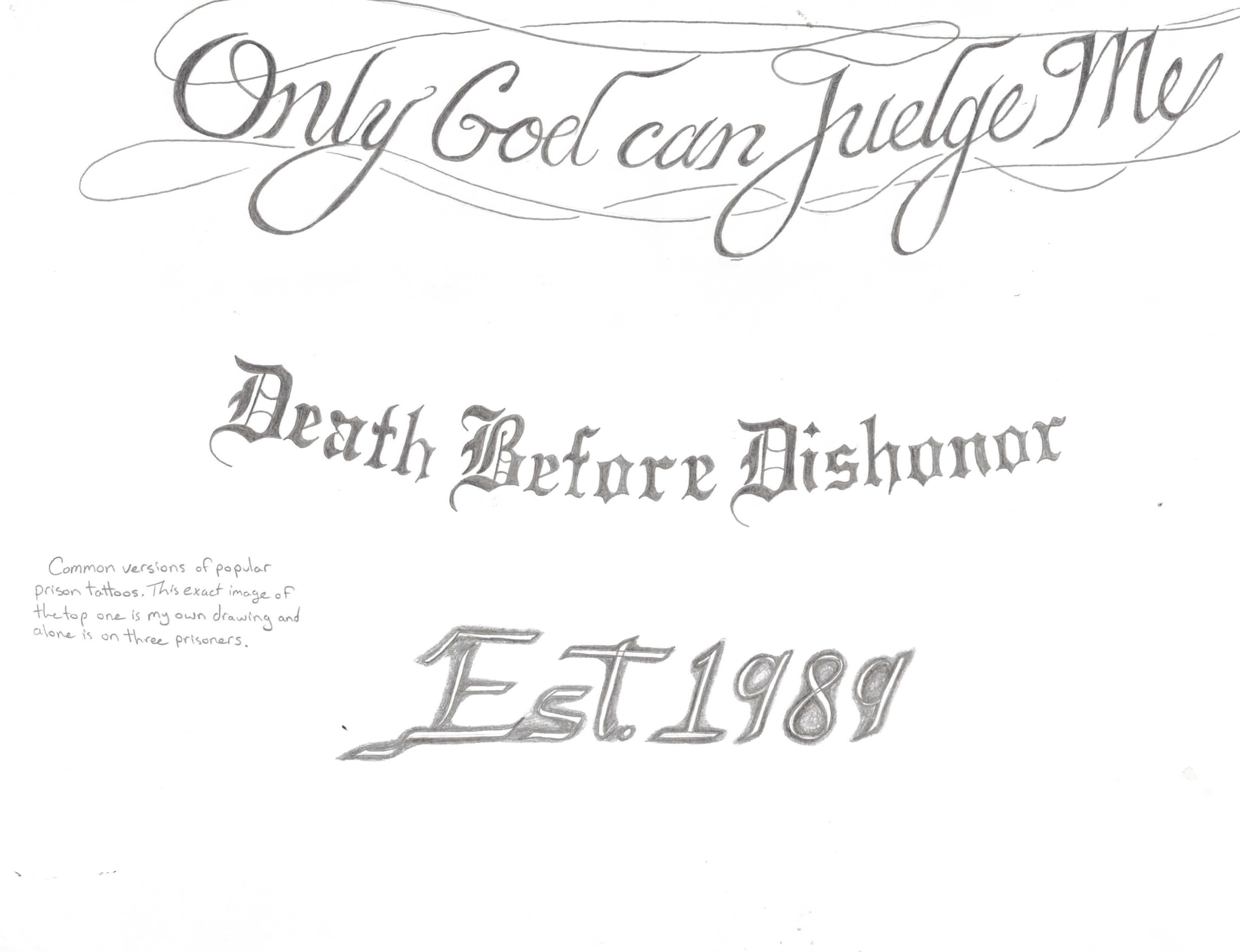
But these images don’t necessarily identify you as an ex-con. There are probably hundreds of thousands of other people that have never been to prison who have these very same tattoos. This is because the different stylistic cultures of tattooing have developed both separately and symbiotically with each other. Prison tattoo culture have both taken and given to street culture, both of which do so to some degree with popular tattoo culture. Street artists get locked up, or prison tattoo artists get out and get a job out there. Popular tattoo culture sees something that looks cool, adapts it, and sometimes refines it further. People with higher-quality tattoos get locked up. Prison tattoo artists see new concepts and incredible talent and are inspired to do better work.
Most of the exclusively prison-related tattoos have to do with time. More than any other single image (not counting words) I was asked to tattoo were melting/broken/otherwise-modified clocks, watches, or hourglasses. I have a melting clock dripping down the back of one of my arms, though I prided myself in doing realistic, more Salvadore Dali-esque ones on other people. Clocks cracked, with springs and gears flying out, hourglasses with the sand pouring down into a swirl that connects to another tattoo.
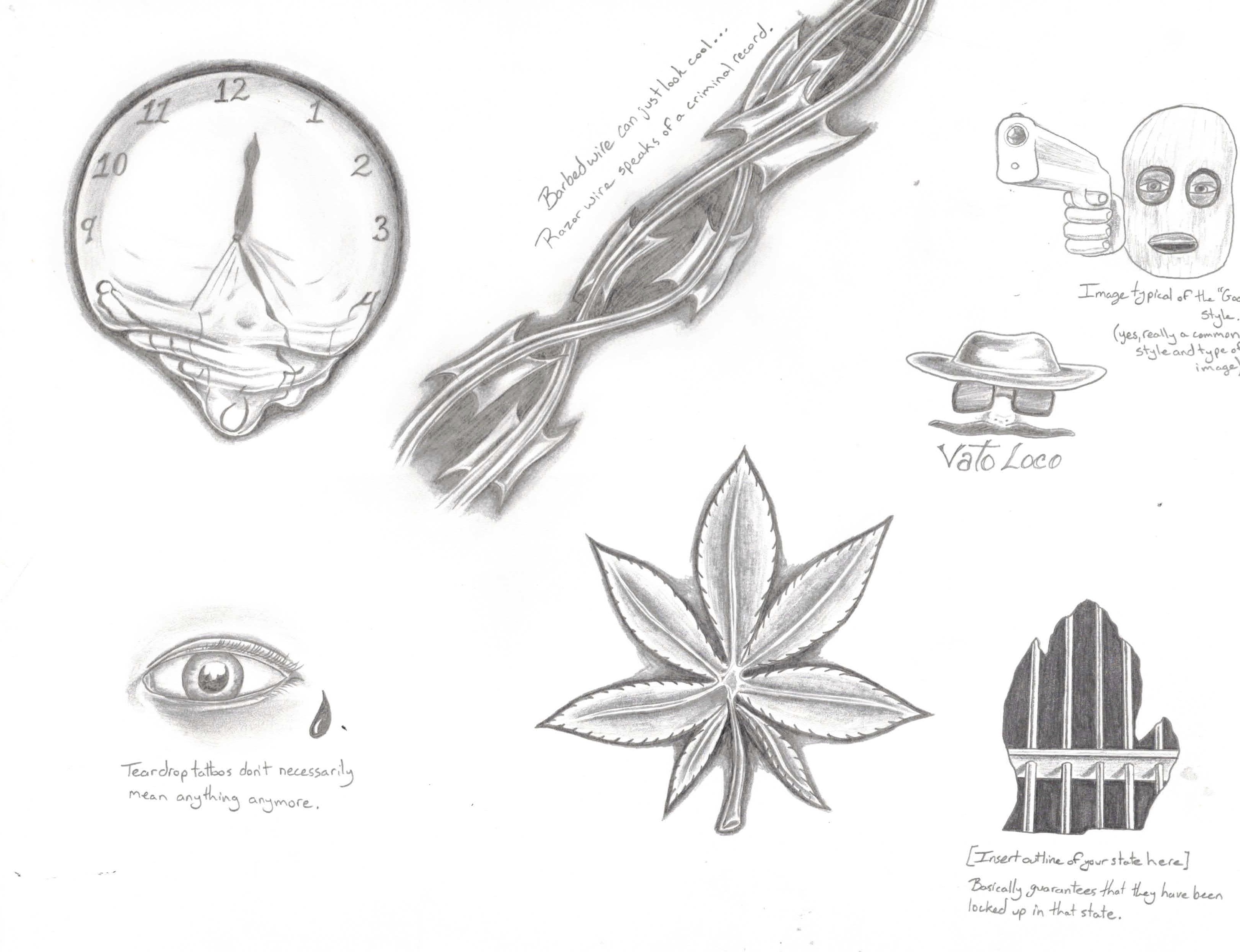
Other almost-exclusively prison tattoo themes revolve around the environment of prison. Sometimes what is most hated becomes part of someone’s identity to show that they have overcome it or no longer fear it. While barbed wire tattoos have been a popular tattoo in pop culture for decades, and don’t necessarily relate to prison, prison razor-wire (also called razor-ribbon) tattoos are almost always prison tats. Tattoos featuring prison guard towers are very common even on prisoners not serving exceptionally long sentences (under ten years), most often inked on the stomach or back. Prison bars are a universal prison tattoo, regardless of state, nation, race, or affiliation. Probably the only single nationally distributed prison tattoo concept, from California to Texas to Michigan to Florida to New York, is the outline of the state the person has been incarcerated in, filled with prison bars. Perhaps no other tattoo can tell you more about someone’s incarceration history within a single glance.
Street Tattoos
Prison tattoos and street culture tattoos have a lot in common, and often overlap. The theme in these relates to the struggle and hustle that comes with growing up in an urban environment. More prisoners come from poverty-stricken urban environments than any other place, and the tattoos they come in with or get while incarcerated reflect this mentality and lifestyle. One of the most popular tattoos asked for in prison relates to the city (or sometimes the street) they’re from: here in Michigan, the word “Detroit,” the Detroit “D”; street signs for “Joy Road,” “Brightmoor,” and “Seven Mile” (main Detroit streets); other main ones here include “Flint,” “Pontiac” (or, “Yak Town”), “GR” (for Grand Rapids), and “Benton Harbor.” This theme follows in every state, and every major city.
Those who aren’t from these environments may be familiar with some of these concepts from modern rap, particularly gangsta rap. When I was tattooing, the one tattoo I was asked to do more than any other single one was the letters “M.O.B.”, which stands for ‘M-oney O-ver B-*tches’, considered a hustler’s words to live by. Another popular acronym, made famous by the Wu Tang Clan, is “C.R.E.A.M.”, ‘C-ash R-ules E-verything A-round M-e’. Tupac’s “Thug Life” is usually visible on a hot day on the torsos of at least a dozen people on any prison yard; same with the word “Goon.”
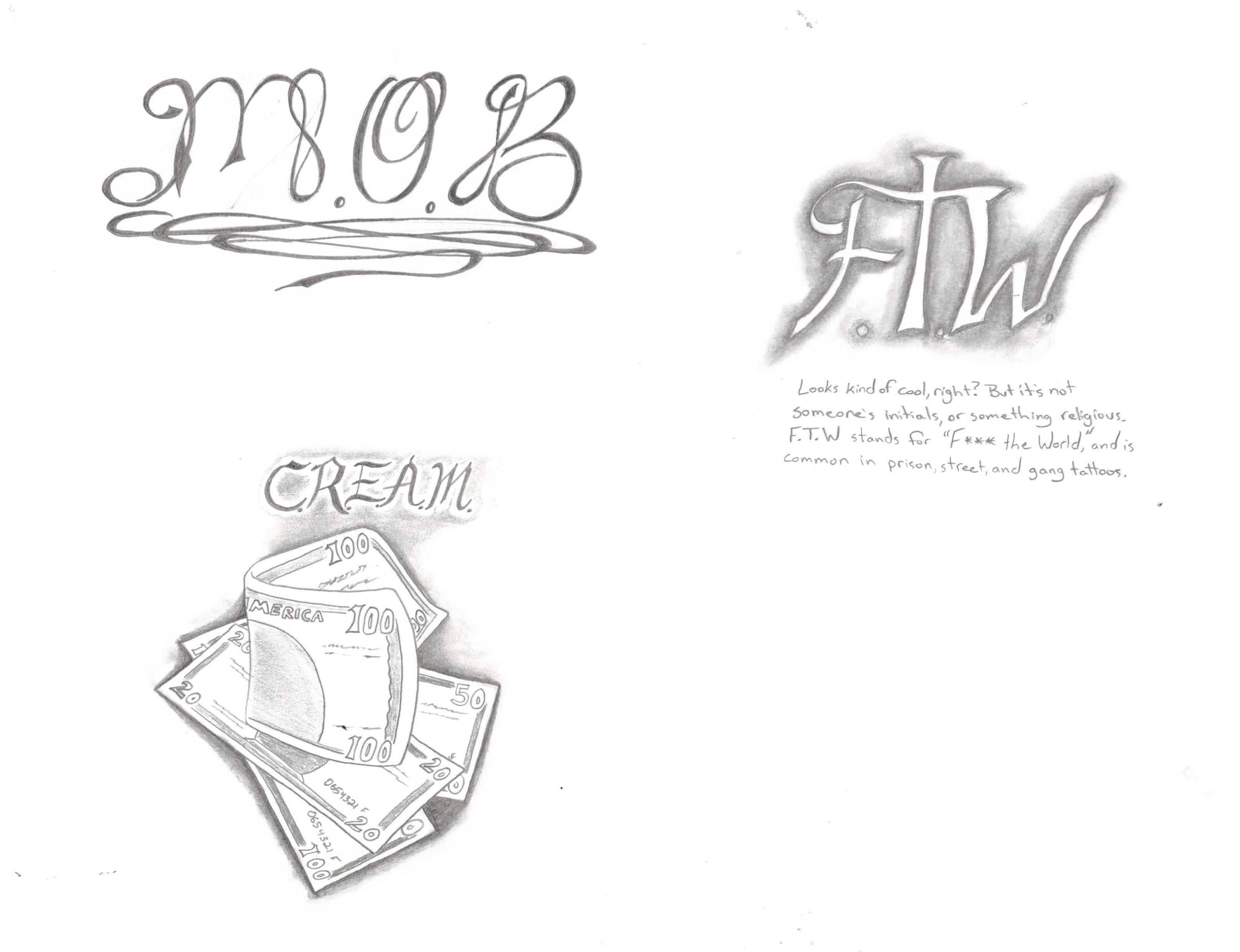
Certain images go with this lifestyle. Guns, particularly pistols and AK-47s, sync with this lifestyle. A common tattoo is two pistols near the bellybutton, placed so that they look like they’re tucked into the person’s waistband. One concept that I myself have seen on probably a hundred people, though it is unrelated to any specific group or gang, is the silhouette of two AK-47s, crossed as though forming a royal crest or seal. Same with the image, of differing quality (stylized outlines or photo-realistic) of a masked man holding out a pistol.
Racial/Ethnic Tattoos
Without commenting too much on issues of race here, it is necessary to present a segment on the differences in prison tattoos between groups, because quite frankly there is a difference in the tattoos that black inmates, Latino inmates, and white inmates get. Many of these simply reflect different aspects of the individual’s personal background or heritage, and don’t necessarily represent claims of racial superiority. Some, however, do. When I tattooed, I worked about equally on anyone who paid, though I refused to do any tattoos that I knew to be racist [as I mention in a later section, I also made a personal choice to never do gang tattoos on anyone].
Black Prisoner Tattoos
Certain tattoos represent aspects of African-American, and specifically African, heritage. Images that show pride are often those that are related to Egypt and its magnificent African history, such as the pyramids and the pharaoh’s headdress/burial-masks. I’ve inked many silhouettes of the continent of Africa, often on arms and chests. There are symbols of Black pride and power (including the words, “Black Power”), such as the Black Panther’s raised fist. Also common are images related to Islam, and specifically the Nation of Islam, such as the crescent moon and star.
Latino Tattoos
No prison tattoo artist’s portfolio can be complete without tattoos that reflect pride in Latino heritage. Words and phrases in Spanish, and the words, “Brown Pride,” are inked on tens- or hundreds-of-thousands of prisoners across the country, though the tattoos and themes themselves have nothing to do with prison and are done even more frequently on the outside. Aztec, Incan, and Mayan warriors and pre-Colombian hieroglyphs often adorn bodies alongside or near images of senoritas (usually naked or almost naked, always well-endowed), sometimes with sombreros and revolvers. Countless other images follow these and are often collaged with these.
White Prisoner Tattoos
With tattoos related to whites, I them down into my own two categories: innocent and racist. Sadly, this section is a bit longer due to the fact that, while there are prejudiced people among all the races, white inmates are pretty much the only ones who choose images that represent disdain or outright hatred for other races.
For the former, there are some images that are more popular among whites than others, though they are by no means specific to them. Two images from personal experience that are merely more common on white prisoners than on others are images of death, such as skulls and demons, and specifically the AR-15 rifle (more white inmates have pistols and revolvers, but the AR-15 is more common on white prisoners than on those of other races/ethnicities). Tattoos related to ethnicity and heritage are common (whether British, French, Russian, German, or Irish), such as a shamrock or four-leaf clover or an Albanian double-eagle. Country-themes are also a differential. Bears, wolves, deer; trees, often silhouettes; the words “Country Strong,” “Country Boy,” and even “Country Pride.”
Some white tattoos skirt the border between innocent and racist. A prime example is the Confederate flag. Today, getting a new image of the Confederate flag would almost always be seen as a racist act. In the past, among those who already have them, the sign can be slightly more ambiguous (though this says nothing of taste either way). This flag is worn by blatantly racist prisoners, as well as those who see it as a Dukes of Hazard-esque symbol of being a rebel. Also in this category is Viking imagery. Odinism and Asatru are the modern pagan religions taken from Norse mythology, the religion of the Vikings, and iconography from these are extremely common on white prisoners across the country, seen as representing the warrior mentality needed to survive in prison. They border the racist boundary because they are specifically WHITE religions, and that warrior mentality they represent can be selected as specifically WHITE warriors fighting against those who aren’t. I have included this in the borderline category because there are legitimate practitioners of the religion and those who bear the images as tattoos. Viking warriors, Thor’s Hammers, and Valknauts are the most common examples.
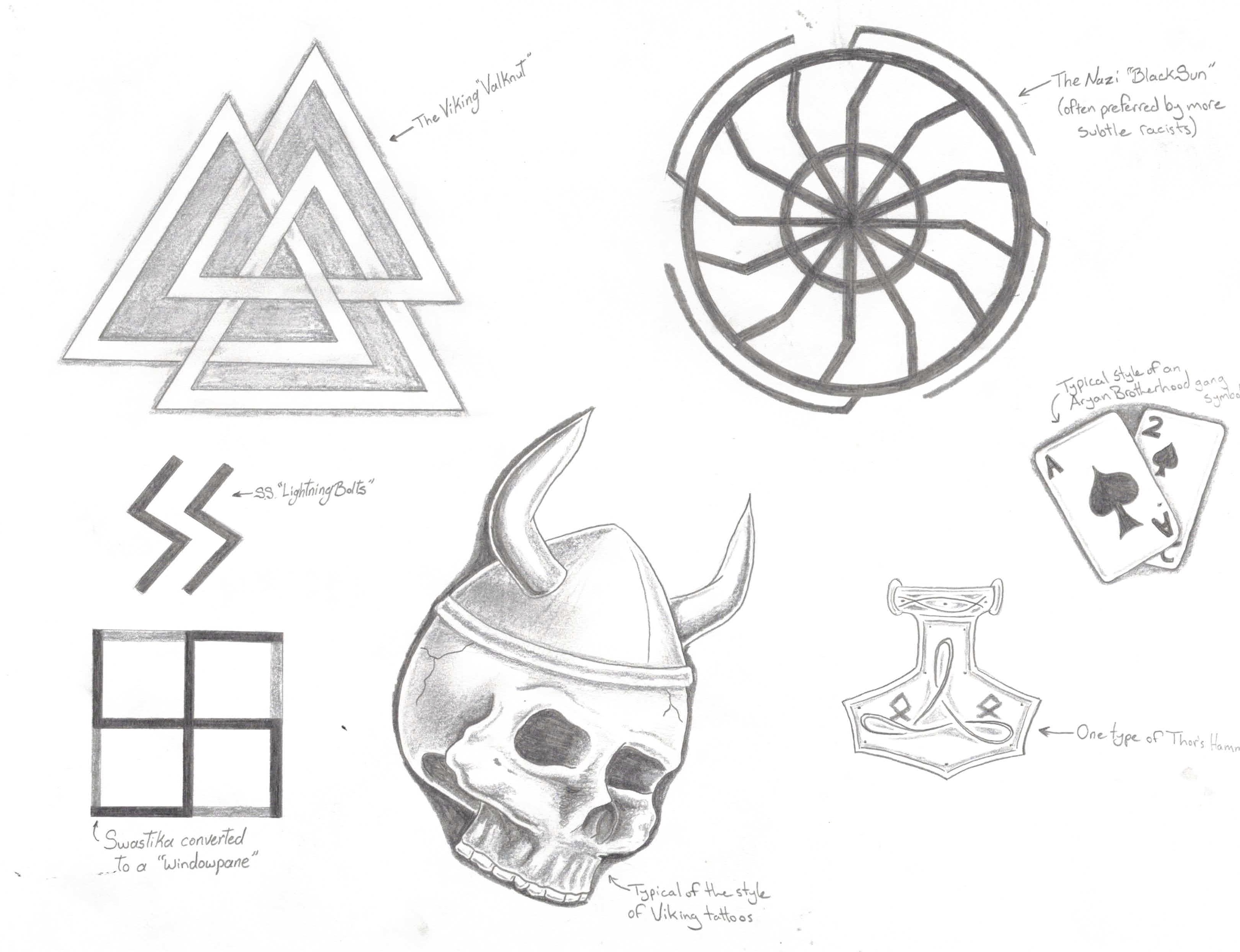
Some of the blatantly racist tattoos are obvious. Swastikas used to be common in the past, though their status as a strike against you as a member of a Security Threat Group (which can place you on heightened restrictions or raise your security level) has convinced many with them to extend the arms to turn them into windowpanes. Whether the Nazi four-armed swastika, or the occasional three-armed or five-armed one, if it looks like a swastika, it almost certainly is. Another Nazi symbol that clearly represents racism are the SS “lightning bolts”, which aren’t the specific domain of any one racist organization but usually signify status as a “made man” in one. A less well-known and obvious one, but with just as much a clear meaning, is the “Black Sun,” a lesser-known Nazi occult symbol.
[Personal Note: I refused to do tattoos that I knew to be racist. However, I was willing to cover up a swastika on a white inmate who was trying to reform his ways and who had renounced his past… and that is why tattoo artists are still necessary in the prison system]
Gang Tattoos
Prison is gang-ridden. Part of surviving inside is learning to understand the different gangs, how they operate, and reading their language in the form of symbols.
The two most infamous street gangs in the entire world are the Bloods and the Crips, and I doubt it will be news to anyone that the Bloods are most often represented by the color red and the Crips by the color blue. But the symbols used by each gang are not as known outside those who have never lived near their claimed territory.
When displays of color aren’t available or pertinent, the Bloods, as well as the somewhat-affiliated Vice Lords, use the five-point star (also called the pentacle, or pentagram) as their emblem, as well as the number five, “5”. Often, the gang is referred to simply as, “the five.” This symbol is displayed on city graffiti, scratched into the paint on prison walls, and tattooed on countless individuals. While the Bloods and VL’s claim the number five, the Crips (and Gangster Disciples) rally around the number six and the six-point star, known more commonly outside of gang-culture as the Star of David or Star of Israel. When I first came in, I naively asked my cellmate, after coming in from the yard on a hot day, why so many prisoners had the Jewish star tattooed on them. “They ain’t Jews, stupid,” he said. “They’re Crips.” Crips also use a trident-looking symbol as their emblem as well. Ever see graffiti or a tattoo of a crown? There’s a high chance it’s gang-related if it has either five or six points on it. Count them.
One of the largest Latino gangs in the US, the Latin Kings, also use the five-point star, often with the name of the gang, just the word “King,” an image of a king in flowing robes with a five-point crown, or the initials “L.K.” or “A.L.K.Q.N” (A-lmighty L-atin K-ing and Q-ueen N-ation). Latin Counts display the name of their gang, or just the word “Count,” often on their stomachs or forearms. Spanish Cobras are most commonly represented by their namesake, an image of a cobra. Other Latino gangs include the Mexican Mafia, which most commonly uses their initials “M.M.” and MS-13, which uses “MS-13,” “MS,” “13,” “Mara Salvatrucha” or a tattoo of their main hand gang sign, which looks like the heavy-metal rock-‘n-roll “devil horns” hand sign.
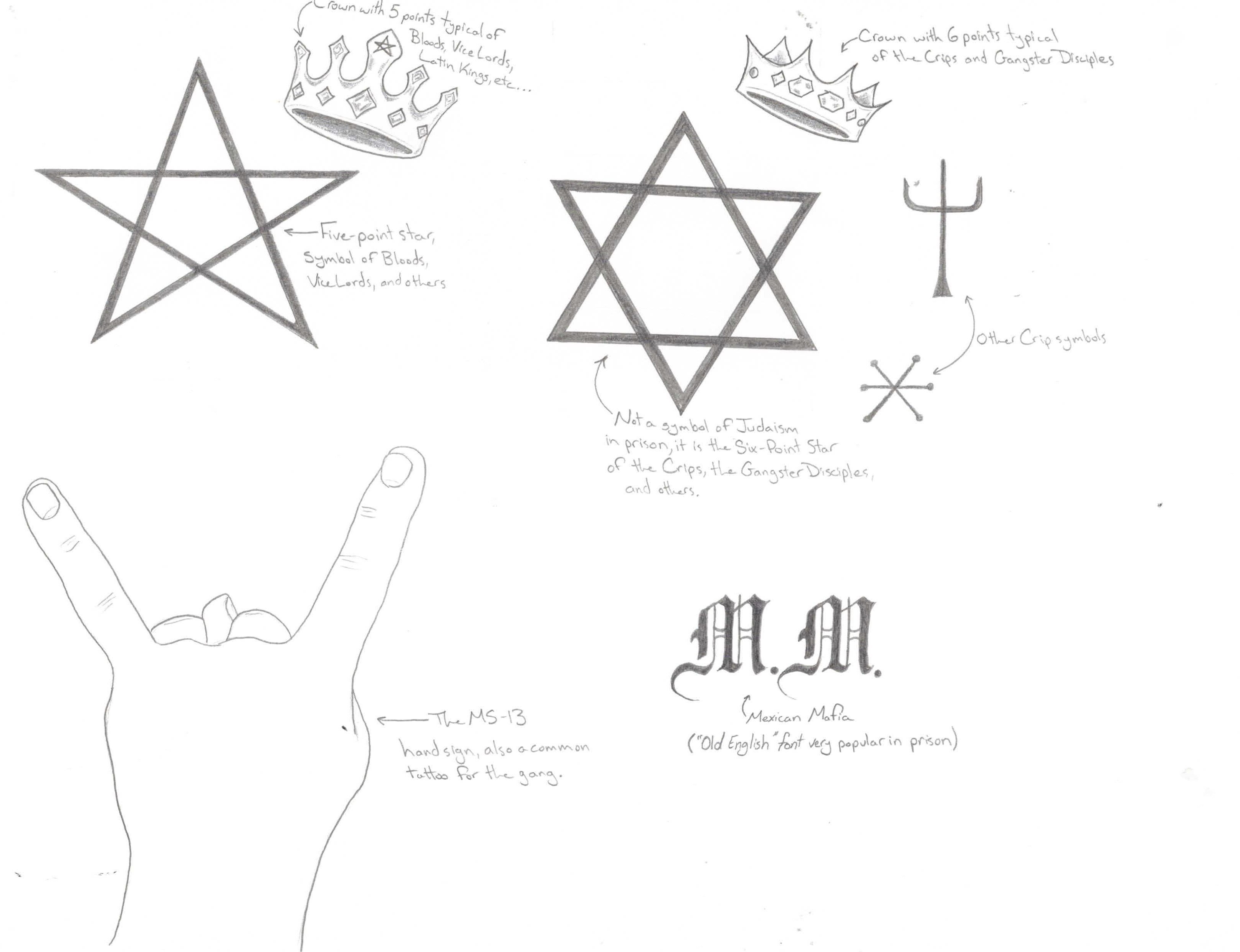
The largest white prison gang in the US is the Aryan Brotherhood, which claims the shamrock, the brand, “A.B.” and often tattoos of the playing cards of an Ace and a Two (for Ace-Deuce, “2” being the second letter of the alphabet, “B”). There are many other white prison gangs. Almost all of them use the swastika and the Nazi SS “lightning bolts.” Different skinhead groups often tattoo the word “Skin” on them, and the Hammerskins, for instance, use the word “Hammer” and “Hammerskin” as well.
One tattoo often associated with gangs and gangster culture is the teardrop tattoo. This tattoo once had a specific meaning that you killed someone if it was in a certain place near a certain eye. While it certainly is true for some old-school gangsters that are left, this tattoo does not have the set-in-stone meaning it used to be because of the prevalence of it among a younger generation who get it having never killed anyone. Old gangsters still have it because it is as permanent as a tattoo. But the meaning has proven to be less-than-permanent.
Prison tattoos have evolved their own unique style and culture, and with the history of mass incarceration in this country, it has become an ever-growing subset of American culture. No prison actually allows tattooing, and so prisoners have learned a lot of methods for improvising the tools we need. Tattoo gun in hand, I did some of the best of them before I stopped to focus on other things and staying more within the rules in order to spend time with my loved ones. But I learned a highly marketable and profitable skill that I plan on pursuing (at least to a degree) when I am released and learning the meanings of prison tattoos has helped me survive and thrive while inside.


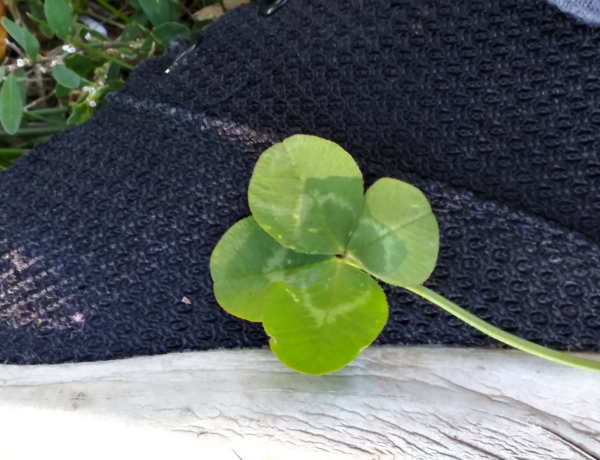


2 Comments
Significations des Tatouages de Prison Décryptées - Obscura
April 20, 2024 at 9:41 pm[…] n’expriment pas un chagrin déchirant ou le regret de mauvaises actions. En réalité, selon Minutes Before Six, les vétérans détenus attribuent une signification spécifique à ces tatouages et peuvent […]
urban ranger
August 4, 2021 at 4:27 pmVery interesting. Thanks, Chris.